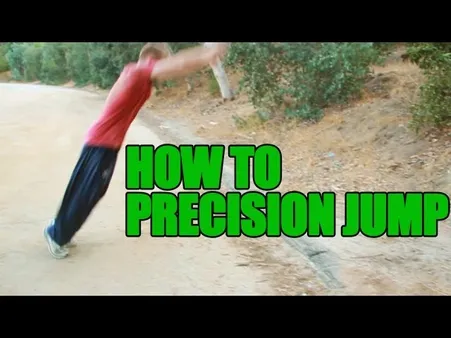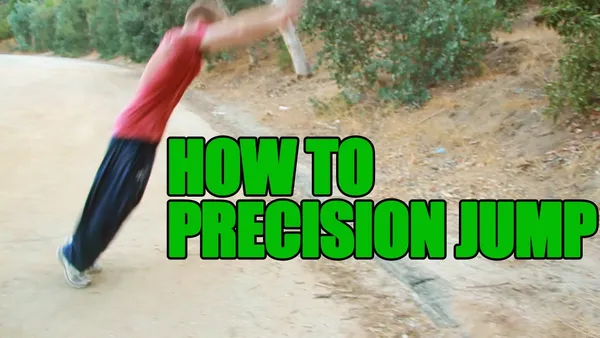Table of Contents
Welcome to Kizworld, your ultimate resource for mastering the art of precision jumping. Unleash your athleticism and take your fitness to the next level with our comprehensive guide on How to do a precision jump. Discover the secrets of this dynamic movement and unlock your true potential. Whether you're a seasoned athlete or just starting out, kizworld has everything you need to become a precision jump master.
How to do a Precision Jump: Master the Art of Accuracy and Control
I. Maximize Your Jumps: A Comprehensive Guide to Precision Jumping
Maximize Your Jumps: A Comprehensive Guide to Precision Jumping
Techniques for Enhanced Precision Jumps
- Master the Two-Step Approach: Initiate your jump with two swift steps, ensuring proper timing and rhythm for maximum power and control.
- Optimize Your Takeoff Angle: Achieve optimal takeoff by maintaining a 45-degree angle, allowing for both height and distance.
- Engage Your Core: Activate your core muscles throughout the jump to stabilize your body and generate explosive power.
- Extend Your Arms and Legs: Fully extend your arms and legs during the jump to increase your reach and maximize airtime.
- Land Softly: Cushion your landing with slightly bent knees and ankles to minimize impact and prevent injuries.
To further enhance your precision jumping skills, check out our comprehensive guide on How to Do a Precision Jump.
Enhance Your Training with Effective Drills
Incorporate these drills into your training regimen to improve your precision jumping technique and overall athleticism:
- Single-Leg Hops: Strengthen your lower body and improve your balance by performing single-leg hops over various obstacles.
- Box Jumps: Increase your vertical leap and power by jumping onto boxes of varying heights.
- Squat Jumps: Build explosive power in your legs by performing squat jumps with proper form.
- Hurdle Jumps: Enhance your coordination and footwork by jumping over hurdles at different heights and distances.
- Depth Jumps: Challenge your muscles and improve your reactive strength with depth jumps from elevated platforms.
For more drills and exercises to elevate your jumping abilities, explore our detailed guide on The Benefits of Gymnastics for Kids.
Safety Measures for Precision Jumping
Prioritize safety during your precision jumping sessions by following these precautions:
- Warm Up Properly: Prepare your body for jumping with dynamic stretches and light cardio to prevent injuries.
- Use Appropriate Footwear: Select shoes with good traction and ankle support to ensure stability and prevent slips.
- Choose a Safe Environment: Practice precision jumps in controlled environments free of hazards and obstacles.
- Start Slowly and Gradually Increase Intensity: Start with low-impact jumps and gradually progress to more challenging techniques as your skills and fitness level improve.
- Listen to Your Body: Pay attention to any pain or discomfort you experience during jumps and stop immediately if something feels wrong.
Discover more safety tips and techniques in our comprehensive article on The Best Gymnastics Equipment for Home Use.
II. Jump Techniques That Work: Step-by-Step Breakdown for Precision
Jump Techniques That Work: Step-by-Step Breakdown for Precision
Mastering the Basic Precision Jump Technique
The foundation of precision jumping lies in mastering the basic technique. Begin with a standing position, feet shoulder-width apart, and knees slightly bent. As you initiate the jump, swing your arms forward and upward, generating momentum. Simultaneously, push off the ground with your feet, extending your legs fully. Upon reaching the peak of your jump, tuck your knees towards your chest and bring your arms down. Land softly on the balls of your feet, absorbing the impact with bent knees.
- Tip: Practice this basic technique repeatedly to develop muscle memory and coordination.
Incorporating Variations for Enhanced Precision
Once you've mastered the basic technique, introduce variations to enhance your precision. Try jumping from different starting positions, such as a squat or lunge. Experiment with different arm movements, such as swinging them sideways or overhead. You can also vary the height and distance of your jumps, gradually increasing the challenge as you progress.
Variation | Description |
Squat Jump | Start in a squat position, then jump vertically, reaching your highest point before landing softly. |
Lunge Jump | Begin in a lunge position, then jump forward, switching your legs in mid-air before landing. |
Side-to-Side Jump | Start with your feet together, then jump sideways, landing with your feet shoulder-width apart. Repeat in the opposite direction. |
Fine-Tuning Your Precision with Advanced Techniques
As you become more comfortable with the basic and intermediate techniques, you can progress to advanced precision jumps. These techniques require greater control, coordination, and athleticism. Some examples include the tuck jump, where you tuck your knees into your chest while in mid-air, and the split jump, where you land with your legs split apart.
Safety and Injury Prevention in Precision Jumping
While precision jumping is a challenging and rewarding activity, it's essential to prioritize safety. Always warm up before jumping to prepare your muscles and joints. Use proper form and technique to minimize the risk of injury. Listen to your body and take breaks when needed. If you experience any pain or discomfort, stop jumping and consult a healthcare professional.
- Tip: Consider wearing appropriate footwear and clothing to support your feet and ankles during precision jumping.
- Related Post: The Best Gymnastics Shoes and Socks for Enhanced Performance and Safety
III. Elevate Your Balance and Coordination: Key Pillars for Precision Jumping
Elevate Your Balance and Coordination: Key Pillars for Precision Jumping
Precision jumping demands exceptional balance and coordination. These attributes enable you to control your body's position and movements accurately, ensuring a safe and successful landing. Here's how you can enhance these crucial skills:
1. Balance Drills:
- Single-Leg Stance: Hold a static position on one leg for 30 seconds, alternating legs.
- Heel-Toe Walk: Walk forward and backward, placing your heel on the toe of your front foot.
- Balance Board: Practice balancing on a wobble board or balance trainer.
2. Coordination Exercises:
- Cross-Body Touches: Stand with your feet shoulder-width apart and touch your right hand to your left foot and vice versa.
- Jumping Jacks: Perform jumping jacks with a focus on maintaining proper form and coordination.
- Agility Ladder Drills: Use an agility ladder to practice footwork patterns and improve coordination.
By incorporating these drills and exercises into your training routine, you'll enhance your balance and coordination, setting the foundation for successful precision jumps.
3. Plyometric Training:
Plyometric exercises are explosive movements that enhance your power and coordination. Include exercises like:
- Box Jumps: Jump onto a box or platform of appropriate height, focusing on a soft landing.
- Squat Jumps: Perform a squat and then jump vertically, reaching your arms overhead.
- Lunge Jumps: Step forward into a lunge position and jump, switching legs in mid-air.
These exercises challenge your muscles and nervous system, improving your ability to generate power and control your movements during precision jumps.
4. Practice Makes Perfect:
Regular practice is essential for mastering precision jumps. Start with basic jumps and gradually increase the difficulty as you gain confidence and skill. Focus on maintaining proper form and technique throughout your practice sessions.
By following these strategies, you'll develop the balance, coordination, and power needed to execute precision jumps with confidence and accuracy. Remember, patience and persistence are key to achieving your jumping goals.
To further enhance your precision jumping skills, consider incorporating these additional tips:
- Warm up properly before each jumping session to prepare your muscles and reduce the risk of injury.
- Choose a safe environment with a soft landing surface to practice your jumps.
- Wear appropriate footwear that provides good support and traction.
- Stay hydrated and maintain a healthy diet to support your training efforts.
With dedication and consistent practice, you'll be able to elevate your jumping abilities and achieve new heights in your athletic pursuits.
For more insights into precision jumping and other athletic skills, explore our related articles:
- How to Do a Handstand: A Step-by-Step Guide for Beginners
- The Benefits of Gymnastics for Kids: Building Strength, Flexibility, and Confidence
- The Best Gymnastics Equipment for Home Use: Creating a Safe and Fun Training Space
IV. Enhance Precision Jumps with Equipment and Gear: Gear Up for Excellence
Enhance Precision Jumps with Equipment and Gear: Gear Up for Excellence
Suitable Footwear: A Foundation for Success
- Select jumpers that combine comfort and stability.
- Opt for designs that offer optimal ankle support and cushioning.
- Ensure the fit is snug, preventing slippage during jumps.
Well-fitting shoes provide a solid foundation, minimizing the risk of injury and maximizing jumping performance.
Specialized Clothing: Enhancing Performance and Comfort
- Choose clothing that allows unrestricted movement and breathability.
- Look for materials that wick away sweat, keeping you cool and dry.
- Consider compression garments to support muscles and improve circulation.
The right clothing enhances comfort, allowing jumpers to focus on executing precise jumps.
Visit our related post: Essential Gymnastics Equipment for Home Workouts
Incorporating these tips will elevate your precision jumping, propelling you towards your athletic goals. Stay tuned for more insights on mastering the intricacies of precision jumps in the upcoming section.
V. Conclusion
With persistence, dedication, and a commitment to safety, you can achieve precision jumping mastery. Remember, practice is key to refining your technique and improving your jumping ability. Always prioritize proper form and listen to your body to prevent injuries. Embrace the challenge of precision jumping and unlock the doors to enhanced athleticism, agility, and coordination. Seize the opportunity to soar higher, jump farther, and leave your mark on the world of precision jumping.